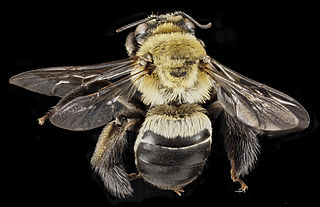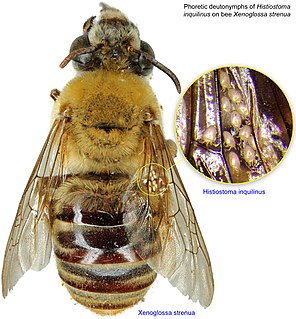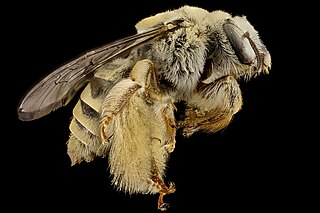
Diadasia is a genus of bees in family Apidae. Species of Diadasia are oligolectic, specialized on a relatively small number of plant species. Their host plants include asters, bindweeds, cacti, mallows, and willowherbs, although mallows are the most common and likely ancestral host plant for the whole genus. Its tribe is Emphorini. In the Sonoran Desert, Diadasia rinconis is considered the "cactus bee" as it feeds almost exclusively on a number of Sonoran Desert cactus species, its life cycle revolving around the flowering of the native species of cacti.

Svastra atripes is a species of long-horned bee in the family Apidae. It is found in North America.

Anthidiellum is a genus of rotund resin bees in the family Megachilidae. There are more than 60 described species in Anthidiellum.
Syntrichalonia is a genus of exquisite long-horned bees in the family Apidae. There are at least two described species in Syntrichalonia.

Dufourea marginata is a species of sweat bee in the family Halictidae. It is found in North America.

Ericrocis is a genus of centris-cuckoo bees in the family Apidae. There are at least four described species in Ericrocis.

Melissodes communis, the common long-horned bee, is a species of long-horned bee in the family Apidae. It is found in Central America and North America.

Xenoglossa is a genus of large squash bees in the family Apidae. There are about 11 described species in Xenoglossa.

Melecta pacifica is a species of hymenopteran in the family Apidae. It is found in North America.

Diadasia diminuta, the globe mallow bee, is a species of chimney bee in the family Apidae. It is found in Central America and North America.

Eucera frater is a species of long-horned bee in the family Apidae. It is found in North America.

Diadasia enavata, the sunflower chimney bee, is a species of chimney bee in the family Apidae. It is found in Central America and North America.
Nomada crotchii is a species of nomad bee in the family Apidae. It is found in North America.
Nomada edwardsii, the Edwards' nomad bee, is a species of nomad bee in the family Apidae. It is found in Central America and North America.

Svastra petulca is a species of long-horned bee in the family Apidae. It is found in Central America and North America.
Diadasia ochracea, the ochraceous chimney bee, is a species of chimney bee in the family Apidae. It is found in Central America and North America.

Diadasia rinconis is a species of chimney bee in the family Apidae. It is found in Central America and North America.

Paranthidium jugatorium is a species of bee in the family Megachilidae. It is found in Central America and North America.

Nomada affabilis is a species of nomad bee in the family Apidae. It is found in North America.

Svastra obliqua, the sunflower bee, is a species of long-horned bee in the family Apidae. It is found in Central America and North America.
















